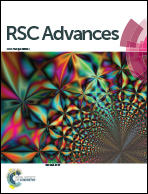Endowing a cationic hydrophobic associating polyacrylamide solution with CO2 switchable properties using N,N-dimethylolamidopropylamine via the assembly transition between vesicles and spherical micelles by CO2†
Abstract
Carbon dioxide triggers have attracted much attention due to their low cost, non-toxicity, simplicity and environmental benignity. N,N-dimethylolamidopropylamine (DOAPA) is a CO2 switchable surfactant, the properties of which can be regulated by CO2 easily. A mixture of a cationic hydrophobic associating polymer (PAD) and the CO2 switchable DOAPA was prepared, which endowed the non-switchable PAD solution with CO2 switchable properties. Then the viscosity and rheology behaviors of the solution were investigated under different pH conditions, with or without CO2. The PAD–DOAPA mixture can be stimulated by CO2 to alter the viscosity of the solution dramatically, with DOAPA assembled as vesicles at a pH of 6.8, and with a water-like viscosity at a pH of 6.0. The reversible transitions of micelle structure and viscosity can be recycled several times through the bubbling and removal of CO2. Most important of all, the viscosity of the PAD–DOAPA system increased over time, which is different from the usual hydrophobic associating polymer–surfactant system, in which the viscosity has a maximum which decreases with further surfactant addition, due to the assembly of DOAPA into vesicles. Finally, a reasonable mechanism is proposed, based on the molecular structures, micelle assembly and intermolecular interactions. Upon the removal of CO2, the assembled form of DOAPA changed from vesicles to spherical micelles, which shielded the hydrophobes and dissociated the gel into a sol. PAD–DOAPA aqueous systems with CO2-reversible properties have wide applications in the fields of oil and gas production.


 Please wait while we load your content...
Please wait while we load your content...